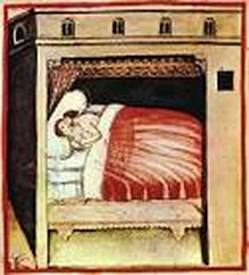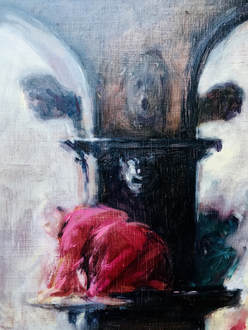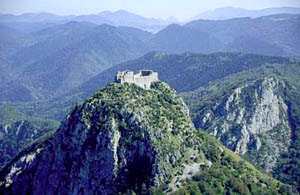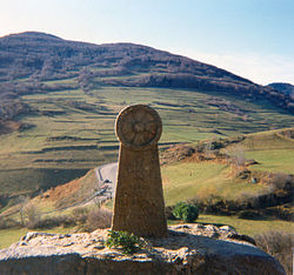“There is no document of civilization that is not also a document The poet Ed Dorn observed that the Cathars were persecuted so vigorously "because heretics are the only ones who really care about religion". In fact, Catharism, except in the hearts and minds of the Perfecti, is a pretty laid-back form of religion, particularly for those times. It is, as Stephen O'Shea titles his book, The Perfect Heresy. But it does cause the Pope sufficient cause for concern to the extent that he launches a crusade or two against it, and subsequently, after 1229, assorted Popes initiate another century of inquisition, interrogation and torture. It is an inquisition, between 1318 and 1325, on which we will focus. During this period, 98 people were subjected to 578 interrogations. And one of them is the star of this particular show - Béatrice de Planissoles, the châtelaine of Montaillou. I'm using the spelling with a double s and a single l because this is the form used by Emmanuel Le Roy Ladurie in his ground breaking, "brilliant but wayward" portrait of life in the medieval village of Montaillou, from which much of her story - including this modest summary - is derived. But other spellings are available. And so you know, de Planissoles is her maiden name. Subsequently, through marriage, she becomes briefly de Roquefort (who is the actual châtelain of Montaillou and dies young), and de Laglaize (who also dies young in 1308). During her marriages and later, Béatrice gives birth to at least seven children, is raped, is an adulterer several times over and is a 'mistress' pretty much passim. It is her sex life which seems preoccupy many historians who affect to be writing about Catholicism and the Cathars. So if I do anything, it will be to redress the balance, although her relationship with Pierre Clergue, the local priest and member of the richest family in the village, is 'seminal' in both religious and sexual terms and will therefore receive a great deal of not always prurient attention. But first, let's spend a moment setting the scene and discussing briefly what all the fuss is about. Catholicism v Catharism There is no single set text which defines the Cathars or explains their beliefs, and much of the information we have about them comes from the opposition to them. But, in simple terms, they are dualists, survivors of the old Manichean heresy. They believe that a good god and a bad god co-exist: the former is the god of immaterial, spiritual things; the latter is the god of material things, of the - inherently evil according to the doctrine of Original Sin - flesh. Now, if you're a Catholic and you've read St Augustine, who was also a Gnostic Dualist, there's no serious issue here. And those Catholics who shared the Cathar distaste for the mercenary trappings of the established church and its priesthood struggle to find any evidence of heresy. Here's Eberwin, Prior of the Abbey of Steinfield, writing to Bernard of Clairvaux, later - after he died - Saint Bernard: "Of themselves they say: 'We are the the poor of Christ, who have no fixed abode and flee from city to city like sheep amidst wolves, are persecuted as were the apostles and martyrs, despite the fact that we lead a most strict and holy life, persevering day and night in fasts and abstinence, in prayers, and in labour from which we seek only the necessities of life. We undergo this because we are not of this world. But you, lovers of the world, have peace with it because you are of the world. False apostles, who pollute the word of Christ, who seek after their own interest, have led you and your fathers astray from the true path. We and our fathers, of apostolic descent, have continued in the Grace of God and shall so remain to the end of time. To distinguish between us and you Christ said 'By their fruits you shall know them'. Our fruits consist in following the footsteps of Christ." That's written in about 1143. And, coming from a hostile point of view, it is remarkably accurate and objective. It is also a view which is widely shared at this time, especially in the Languedoc, where our focus lies and where, at its height, Catharism is, effectively, the Church - with a structure of bishops and deacons for different areas. Moreover, they have the tacit and sometimes active support not only of the peasantry but also the nobility and a significant proportion of the clergy. Pierre Clergue being one of the latter. It is easy to see why Catharism appeals in Languedoc. Tthe Catholic clergy in the region is notoriously lax apart from when it comes to tax collection and the commitment to a life of poverty and preaching (the Perfecti claim that this makes them the true inheritors of the early apostolic church) stands in stark contrast to the Catholic priesthood. (Incidentally, the mendicant Dominican order springs from this tradition rather than Catholic orthodoxy. Which may be one reason why the Dominicans will be so prominent in the Inquisition.) Malcolm Barber amongst others points out that, “the example set by the lifestyle of the Perfecti was more important than dualistic belief as such”. At the same time, the Cathar rejection of ‘corporeality’, the abstention from meat and sex, and the belief that marriage is sinful because it sanctifies sexual congress (making sex outside marriage less heinous that sex within marriage) is an appealing notion, not least because it applies only to the Perfecti not to the mere believer. The transformation of believers (credentes) to Perfecti takes place through a ritual known as the Consolamentum, which – unsurprisingly – takes place more often than not on one’s deathbed. One crusader reports that credentes believed that they could not sin "below the waist". It’s called having one’s cake, and eating it. And it is as attractive in 11th century Languedoc as it is throughout history. There is, of course, a political dimension to all this. There always is. In this case, it is the need, on the part of the Papacy, to continue its establishment of leadership of the Universal Church, as part of which it is bound to take on theological challenge. And this need coincides with the long-term desire of the French to extend its power to the south. Don’t forget, southern France speaks Occitan – the langue d’oc (speakers called it Romans). It is different from the rest of Frankish society, without the sense of cohesion which was imposed on and in the north. It does not yet have the sense of itself which it retains even today – that will come to a large extent as a result of the Albigensian Crusades – but it is a more open, freer, society in many respects, the land of the troubador. From Béziers to Montségur What changes is the combination of the Church need to establish theological control and the French feudal nobility’s need to take political control. With “a crusading Pope”, Innocent III, offering indulgences to knights on the one hand, and French nobles such as the Duke of Burgundy, the Count of Nevers and the Count of Monfort on the other, the crusade was launched from Lyon in late June 1209 and made rapid and terrifying progress. By 21 July it had reached the walls of Béziers. Raimon-Roger Trencavel, the young count leading what resistance there is, decides the city is not defensible and decamps for Carcassonne, accompanied by the Jewish community who are only two aware of what has happened to Jews in the north. But the citizens of Béziers are made of sterner stuff. Despite an appeal from their bishop to surrender, they decide to resist. Resistance lasts merely two or three hours, according to the Pope’s legate and abbot-commander, Arnald-Amalric, but the massacre - le Grand Mazel - lasts all day as the citizens rush into the cathedral and churches for protection. It is now that Arnald-Amalric is, allegedly, asked how the crusaders can distinguish between Catholics and heretics and replies, “Kill them all. God will know his own.” Whether he says it or not, it is certainly true that the inhabitants of the town are massacred – citizens, clerics, women and children inside the churches. All 20,000 of them, according to Arnald-Amalric’s report to the Pope. ("Today your Holiness, twenty thousand citizens were put to the sword, regardless of rank, age, or sex".) Reportedly, not a single person survived. The figure is almost certainly an exaggeration, given that the total population of Béziers at the time is half that. But the massacre is part of the way in which war is waged, making an example of the first victims 'pour encourager les autres'. The news of the brutality prompts Narbonne to surrender unconditionally, offering also to hand over their heretics. Other towns also turn on their Cathar friends and neighbours to avoid the terrible retribution of the Crusade. The fortress of Carcassonne, the military key to the region, falls before the winter break and, with new crusaders arriving in the spring, the campaign of conquest continues with Minerve, where 140 Perfecti were burned on a huge pyre, having proclaimed that “neither death nor life can separate us from the faith to which we are joined”. It is the first but not the largest of these mass burnings. That is probably the four hundred or so in Lavaur, where, also, the chatelaine is thrown into a well and stones piled upon her until her screams can no longer be heard. But the most famous and iconic is surely Montségur in 1244. Yes, thirty five years later. And throughout the entire period, long after the crusade has come an official end in 1229, the fortress of Montségur stands as a provocative symbol of resistance to church and state. Here, by 1240, some 200 Perfecti (who as pacifists cannot and will not fight) are protected by a force of 200 knights, who certainly can and will and who, on occasion, venture out to dispense justice and wreak revenge on the enemy. One such is the murder of two inquisitors, William Arnald and Stephan de Saint-Thibéry, as well as their retinue, by fifty men from Montségur on 28 May 1242. This is the action that prompts the final and successful attack on the fortress. The siege lasts for 10 months and, until the end, achieves little and has even less hope of success. The end comes after an extraordinary climb under cover of darkness which seizes a tower on a minor summit. A contemporary report, from one William de Puylaurens, records that when dawn broke the climbers “saw with astonishment the terrible route which they climbed in the night, which they would never have dared to try in the daylight”. They are still below the castle, but they have a base from which to bombard the citadel and by February 1244, they are so close that negotiations for a surrender are begun. By the standards of that time, the Cathars are offered a good deal. Civilians and soldiers may leave. Only the Perfecti and those credentes who refuse to recant are sentenced to death. They are given fourteen days to abjure. And fourteen days later, without exception, they walk into “the flames of Tartarus” and into history. Montaillou The crusades are clearly successful in political terms. It is debatable, however, to what extent Catharism as an everyday religion is extinguished. Perfecti have been burned, noble protectors and sympathizers of Catharism overthrown, but it remains a force in the lives of much of population. In 1226, the year that Louis VIII progresses through the Midi and issues a decree that all heretics will be subjected to animadversion debita (‘due punishment’) and all supporters branded, the Cathars still manage to hold a Council at Pieusse, just 18 kilometres from Carcassonne, at which 100 or more Perfecti are present, and during which a new Cathar bishopric is created in the Razés. You don’t do that unless it is spiritually and practically feasible, unless you have believers and cash and support. True, Montségur is a huge blow, but it is not the end. In fact, Catharism undergoes something of a revival and Montaillou, together with the contiguous hamlet of Prades, is at its heart. In 1308, Geoffroy d’Ablis, the Inquisitor of Carcassonne, arrests the entire population of the village over the age of fourteen on charges of heresy. With good reason. Pierre Autier and about sixteen ‘good men’ have evangelised the region successfully, starting around 1300. And although Autier and his brother go to the stake in 1310, peasants and shepherds, artisans and small shop-keepers quietly continue their heresy. It is a later inquisition between 1318 and 1325 which is our concern here. The historian RI Moore describes it as “only a mopping-up operation” but is not regarded as such at the time. In fact, it is led by the formidable Jacques Fournier, a doctor of theology from Paris University, currently the Bishop of Parmier, and soon to be Pope Benedict XII, and it has two objectives of which the religious is probably the least important. The primary mission is the destruction of those families and social elements which are local centres of power and influence. Of course, the two are interlinked, because Catharism thrives in domestic settings. As opposed to the Church institutions, the outward focus of Catholicism, the practice of Catharism takes place out of sight in the home – domus in latin, ostal in the vernacular. Moving from house to house, the Perfecti teach, console, entertain. This makes the ostal – particularly that of the Clegues – a particular focus for its attentions. If this social and political emphasis is correct, and it is argued convincingly and to my satisfaction by Jean Duvernoy amongst others, then the Clergue family and its most favoured son Pierre is the number one target in Montaillou. And Béatrice herself is not without influence – of noble birth, albeit minor nobility, married twice into landed families and if not rich, certainly better off than the rest of the village. This makes her a target for Pierre Clergue on the one hand, seeking to ensure the influence of his family, and also a relatively easy target for a Parisien theologian and future Pope. But in 1318, the future Pope is merely ‘Monsignor Jacques’, praised by his Catholic superiors, loathed by local people for his harassment of them, What makes him noteworthy, however, is not only the rigour with which he carries out his duties, but the level of detail he requires and elicits from his suspects, and his meticulous recording of that information. Prominent in the Fournier Register dealing with no less than twenty-eight accused residents of Montaillou and Prades (out of about 250) is Béatrice de Planissoles, once châtelaine of the village. Curiously, there is no account of any interrogation of Pierre Clergue, the priest in Montaillou, whose lechery was as overt as his heresy was discreet and who is, without doubt, the principal target of this inquisition. One assumes his deposition is missing rather than it never taking place. We do know however that he was arrested and imprisoned, and that his brother Bernard offers other accused bribes to give false evidence. And we also know that he dies in prison in 1321, as does Bernard, whose sentence is murus strictus, which means that he is shackled 24 hours a day and given only bread and water. The evidence against the Pierre of our story comes primarily, though not exclusively, from Béatrice. It is sufficiently damning for Pierre himself to attempt to bribe his cell-mate, the ‘vicaire’ Barthélmy Amilhac, to persuade Béatrice to withdraw her evidence against him. So what is Béatrice’s evidence? Initially, very little. When she is first deposed, on 26 July 1320, Béatrice is faced with a combination of charges, which include witchcraft as well as heresy. Fournier knows that her family has a Cathar pedigree, and that her father had been a Cathar, and he quotes to her Matthew 7/17: “every good tree bringest forth good fruit; but a corrupt tree bringest forth evil fruit”. He also knows that she has a relationship with the most notable heretical family in the region, the Authiés of Ax, three of whom are Perfecti. But at this point, he is not questioning her under oath, and the accusations are relatively minor - a joke about the Host ("You believe that what the priests hold on the altar is the body of Christ! Certainly, if that was the body of Christ and even if it was as big as this mountain (gesturing toward Mont Margail), the priests by themselves would already have eaten it!") and a lackadaisical approach to attending Mass. Only after this relatively gentle start to the questioning, does he set a date for a more formal interrogation, this time under oath. Béatrice panics and does a runner, but is soon located and arrested in the company of her lover, a young priest by the name of Barthélemy Amilhac. This time she has, in her possession, a number of items - her sons’ umbilical cords, underwear stained with menstrual blood from a daughter’s first period, which provide the evidence of sorcery. But Fournier is more interested in something else which she carries with her: some dried bread which Fournier knows immediately is Cathar consecrated bread. And Béatrice knows he knows. From her original denials, evasion and prevarication, Béatrice changes tack and tells it all. There is an English language translation of the relevant passage from the Fournier Register at http://www.sjsu.edu/people/nancy.stork/courses/c4/s1/Beatrice_de_Planissoles but here’s a sample, in which she describes her relationship with Pierre Clergue. And drops him in it. “Later, towards Easter, he came to visit me many times, and asked me to give myself to him. I said one day when he was soliciting me in my own home that I would rather to give myself to four men than to one priest, because I had heard that a woman who had been known carnally by a priest could not see the face of God. To which he responded that I was stupid and ignorant, because the sin was the same for a woman to be known by her husband or by any other man, equally whether the man was her husband or a priest. It was an even greater sin with a husband, he said, because the spouse believed she did not sin with a husband, but she had a conscience with other men. The sin was therefore greater in the first case.” We, as does Fournier, recognize this as a statement of Cathar orthodoxy. And Béatrice knows exactly what she is saying. But, just to be sure the blame will lie firmly with Clergue, she continues: “I asked him how he could talk thus, being a priest, because one said in church that marriage had been instituted by God and that it was the first sacrament, instituted by God between Adam and Eve, so that there would be no sin when spouses knew one another. He replied ‘If it was God who instituted marriage between Adam and Eve, and if he created them, why did he not guard them from sin?’ I understood then that he was saying that God did not create Adam and Eve and had not instituted marriage between them. He added that the Church taught many falsehoods. The ecclesiastics said this, because they were not inspired by respect or fear. Indeed, in part of the Gospel and the Pater, and all the other texts of Scripture were ‘affithas’, a word that one uses in the vulgar tongue to designate words that one adds to what one has heard. I replied to him that because of this the ecclesiastics plunged the people into error.” This confession is the beginning of the end for Catharism in Montaillou, and the events she describes are also the beginning of an affair which lasts for some two years. It starts in church, of course, when she comes to make her confession. “I prefer you to any woman in the world” he tells her. It is pretty much the same line he uses on the other (at least) dozen ‘concubines’ but it works with Béatrice as well as it works with the others. He is a good lover, and not only according to Béatrice. Grazide Rives, just fourteen at the time, recounts her encounter with Clergues to Fournier with relish. “With Pierre Clergue, I liked it. And so it could not displease God.” Under oath, Béatrice remembers it all: how he brings her bed into the church so that they could sleep together within the ‘holy’ walls; how they delouse each other by the fire; how she listens as he explains that the fortunes of the Clergues would be greater without providing dowries had brothers been allowed to marry sisters; how he arrives at their assignations armed with herbal contraceptives; how, when she falls seriously ill during her second marriage, Clergue encourages her to allow the administration of the Cathar consalamentum’. Béatrice talks on and on throughout August 1320. She talks so much that it makes her ill, so ill that Fournier calls a special session at which he proofs her confession, concerned that she may die. She doesn’t – at least not yet. In fact, she recovers sufficiently to review her evidence and actually correct Fournier on one misattribution in the record. By the time she is released, at the same time as Amilhac, she has served 15 months in prison and Fournier sentences her to wear the double yellow cross, “one to be worn on the front of the chest and the other between the shoulders”, for the rest of her life. (Amilhac, who has in his testimony calls her a “wicked old woman” and a “heretic”, gets off lightly: he is sentenced only to the recompensation of his sins, which is no punishment at all. Duvernoy sees this as further evidence of the Church’s bias towards those with perceived power.) The yellow crosses – the parallel with the yellow badges the Catholic church enforced on Jews is unmistakeable – are warnings to good Catholics to keep away from those wearing them. they are known locally as las debanadoras, winding machines. The name reflects the fact that wearers can be ‘reeled in’ by the inquisition at any time for a second inquisition and probable second conviction, for which there is only one punishment: death. We know nothing of her life after she is released from prison, apart from what our lack of knowledge tells us: it would appear that she was not sentenced to death; nor did she return to Montaillou; nor did she receive the Cathar consolamentum. Or at least there are no records of any of this. We know that the Clergues continue to flourish. 650 years later, they are still the leading family in Montaillou and, in 2014, the Mayor is Jean Clergue who has taken over from, yes, one Pierre Clergue! But Béatrice simply disappears from history, perhaps living her particular blend of Catholicism, Catharism, and folklore. Until, centuries later, in Ladurie’s Montaillou, history finds her again. Vertical Divider
|



